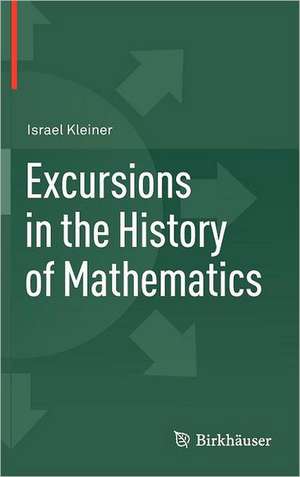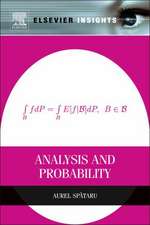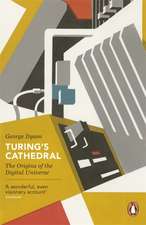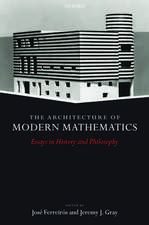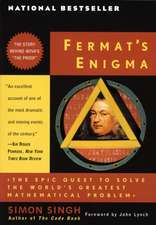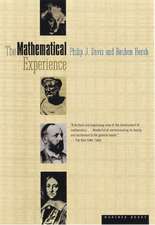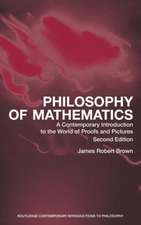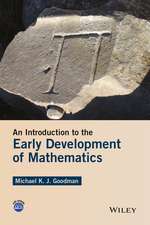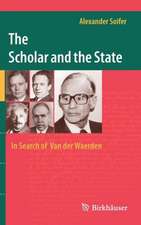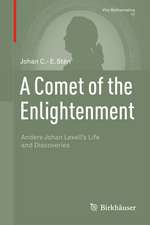Excursions in the History of Mathematics
Autor Israel Kleineren Limba Engleză Hardback – dec 2011
Excursions in the History of Mathematics was written with several goals in mind: to arouse mathematics teachers’ interest in the history of their subject; to encourage mathematics teachers with at least some knowledge of the history of mathematics to offer courses with a strong historical component; and to provide an historical perspective on a number of basic topics taught in mathematics courses.
Preț: 593.91 lei
Preț vechi: 698.72 lei
-15% Nou
Puncte Express: 891
Preț estimativ în valută:
113.66€ • 123.42$ • 95.47£
113.66€ • 123.42$ • 95.47£
Carte tipărită la comandă
Livrare economică 22 aprilie-06 mai
Preluare comenzi: 021 569.72.76
Specificații
ISBN-13: 9780817682675
ISBN-10: 0817682678
Pagini: 347
Ilustrații: XXI, 347 p. 36 illus.
Dimensiuni: 155 x 235 x 22 mm
Greutate: 0.69 kg
Ediția:2012
Editura: Birkhäuser Boston
Colecția Birkhäuser
Locul publicării:Boston, MA, United States
ISBN-10: 0817682678
Pagini: 347
Ilustrații: XXI, 347 p. 36 illus.
Dimensiuni: 155 x 235 x 22 mm
Greutate: 0.69 kg
Ediția:2012
Editura: Birkhäuser Boston
Colecția Birkhäuser
Locul publicării:Boston, MA, United States
Public țintă
Upper undergraduateCuprins
A. Number Theory.- 1. Highlights in the History of Number Theory: 1700 BC - 2008.- 2. Fermat: The Founder of Modern Number Theory.- 3. Fermat's Last Theorem: From Fermat to Wiles.- B. Calculus/Analysis.- 4. A History of the Infinitely Small and the Infinitely Large in Calculus, with Remarks for the Teacher.- 5. A Brief History of the Function Concept.- 6. More on the History of Functions, Including Remarks on Teaching.- C. Proof.- 7. Highlights in the Practice of Proof: 1600 BC - 2009.- 8. Paradoxes: What are they Good for?.- 9. Principle of Continuity: 16th - 19th centuries.- 10. Proof: A Many-Splendored Thing.- D. Courses Inspired by History.- 11. Numbers as a Source of Mathematical Ideas.- 12. History of Complex Numbers, with a Moral for Teachers.- 13. A History-of-Mathematics Course for Teachers, Based on Great Quotations.- 14. Famous Problems in Mathematics.- E. Brief Biographies of Selected Mathematicians.- 15. The Biographies.- Index.
Recenzii
From the reviews:
“The book under review was written with two main goals in mind: (1) to arose mathematics teachers’ interest in the history of mathematics, and (2) to encourage mathematics teachers with at least some knowledge of the history of mathematics to offer courses with a strong historical component. … The book can serve teachers of mathematics as well as mathematicians who want to get to know historical background of their subjects. It can be also useful to those teaching or studying the history of mathematics.” (Roman Murawski, Zentralblatt MATH, Vol. 1230, 2012)
“The book under review was written with two main goals in mind: (1) to arose mathematics teachers’ interest in the history of mathematics, and (2) to encourage mathematics teachers with at least some knowledge of the history of mathematics to offer courses with a strong historical component. … The book can serve teachers of mathematics as well as mathematicians who want to get to know historical background of their subjects. It can be also useful to those teaching or studying the history of mathematics.” (Roman Murawski, Zentralblatt MATH, Vol. 1230, 2012)
Textul de pe ultima copertă
This book comprises five parts. The first three contain ten historical essays on important topics: number theory, calculus/analysis, and proof, respectively. Part four deals with several historically oriented courses, and Part five provides biographies of five mathematicians who played major roles in the historical events described in the first four parts of the work.
Each of the first three parts—on number theory, calculus/analysis, and proof—begins with a survey of the respective subject and is followed in more depth by specialized themes. Among the specialized themes are: Fermat as the founder of modern number theory, Fermat’s Last Theorem from Fermat to Wiles, the history of the function concept, paradoxes, the principle of continuity, and an historical perspective on recent debates about proof.
The fourth part contains essays describing mathematics courses inspired by history. The essays deal with numbers as a source of ideas in teaching, with famous problems, and with the stories behind various "great" quotations. The last part gives an account of five mathematicians—Dedekind, Euler, Gauss, Hilbert, and Weierstrass—whose lives and work we hope readers will find inspiring.
Key features of the work include:
* A preface describing in some detail the author's ideas on teaching mathematics courses, in particular, the role of history in such courses;
* Explicit comments and suggestions for teachers on how history can affect the teaching of mathematics;
* A description of a course in the history of mathematics taught in an In-Service Master's Program for high school teachers;
* Inclusion of issues in the philosophy of mathematics;
* An extensive list of relevant references at the end of each chapter.
Excursions in the History of Mathematics was written with several goals in mind: to arouse mathematics teachers’ interest in the history of their subject; to encourage mathematicsteachers with at least some knowledge of the history of mathematics to offer courses with a strong historical component; and to provide an historical perspective on a number of basic topics taught in mathematics courses.
Each of the first three parts—on number theory, calculus/analysis, and proof—begins with a survey of the respective subject and is followed in more depth by specialized themes. Among the specialized themes are: Fermat as the founder of modern number theory, Fermat’s Last Theorem from Fermat to Wiles, the history of the function concept, paradoxes, the principle of continuity, and an historical perspective on recent debates about proof.
The fourth part contains essays describing mathematics courses inspired by history. The essays deal with numbers as a source of ideas in teaching, with famous problems, and with the stories behind various "great" quotations. The last part gives an account of five mathematicians—Dedekind, Euler, Gauss, Hilbert, and Weierstrass—whose lives and work we hope readers will find inspiring.
Key features of the work include:
* A preface describing in some detail the author's ideas on teaching mathematics courses, in particular, the role of history in such courses;
* Explicit comments and suggestions for teachers on how history can affect the teaching of mathematics;
* A description of a course in the history of mathematics taught in an In-Service Master's Program for high school teachers;
* Inclusion of issues in the philosophy of mathematics;
* An extensive list of relevant references at the end of each chapter.
Excursions in the History of Mathematics was written with several goals in mind: to arouse mathematics teachers’ interest in the history of their subject; to encourage mathematicsteachers with at least some knowledge of the history of mathematics to offer courses with a strong historical component; and to provide an historical perspective on a number of basic topics taught in mathematics courses.
Caracteristici
Includes supplementary material: sn.pub/extras
